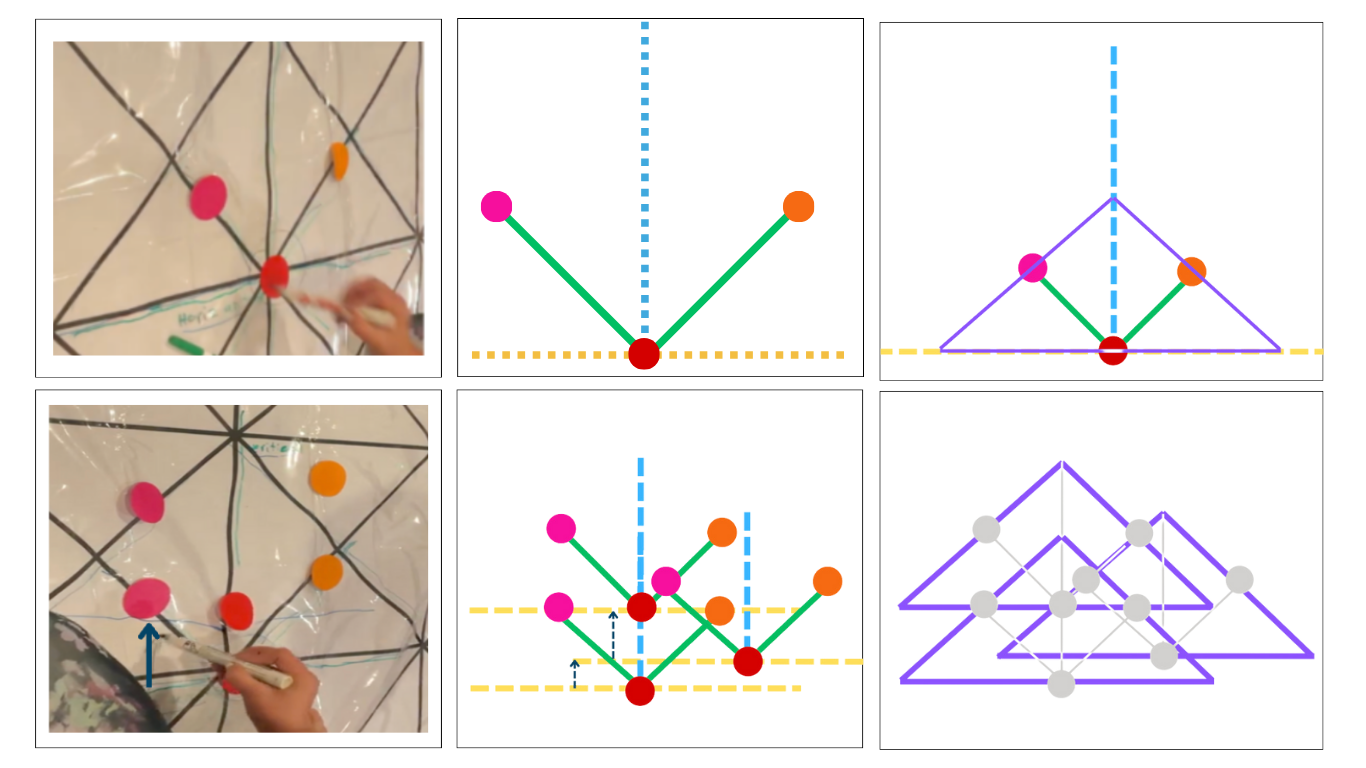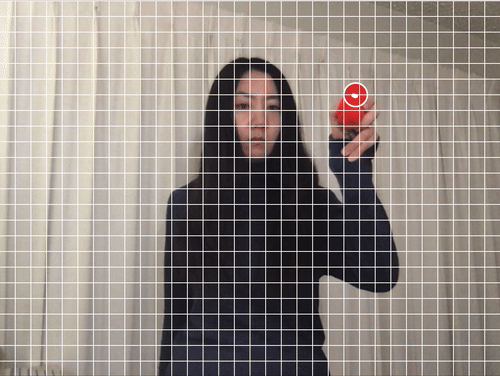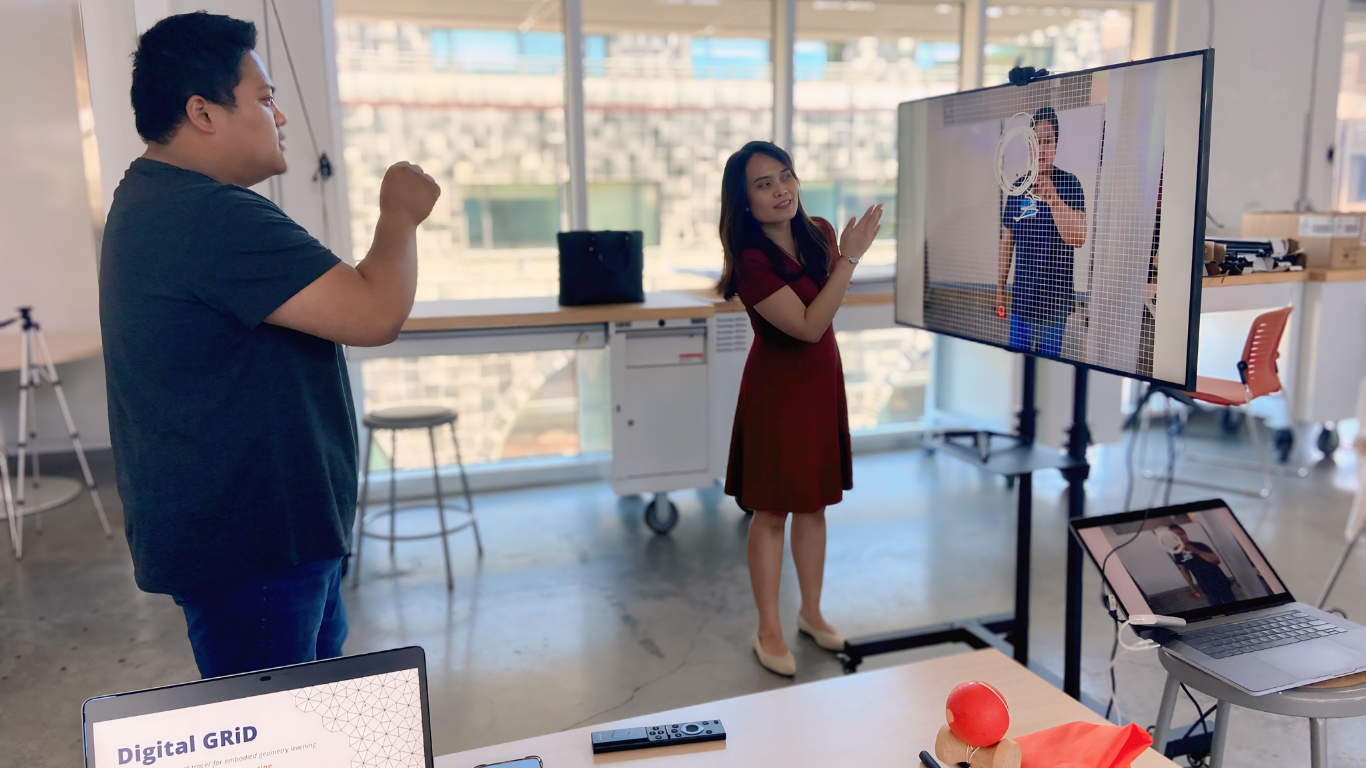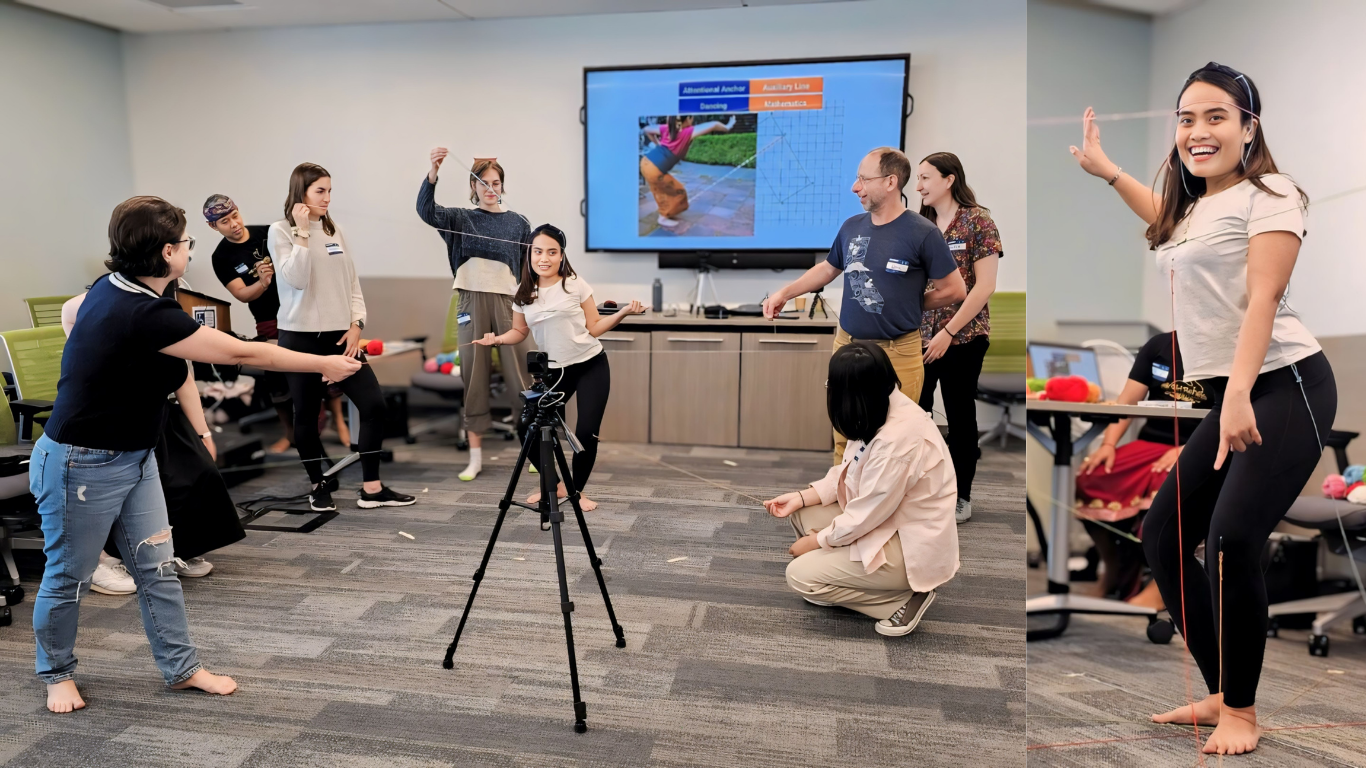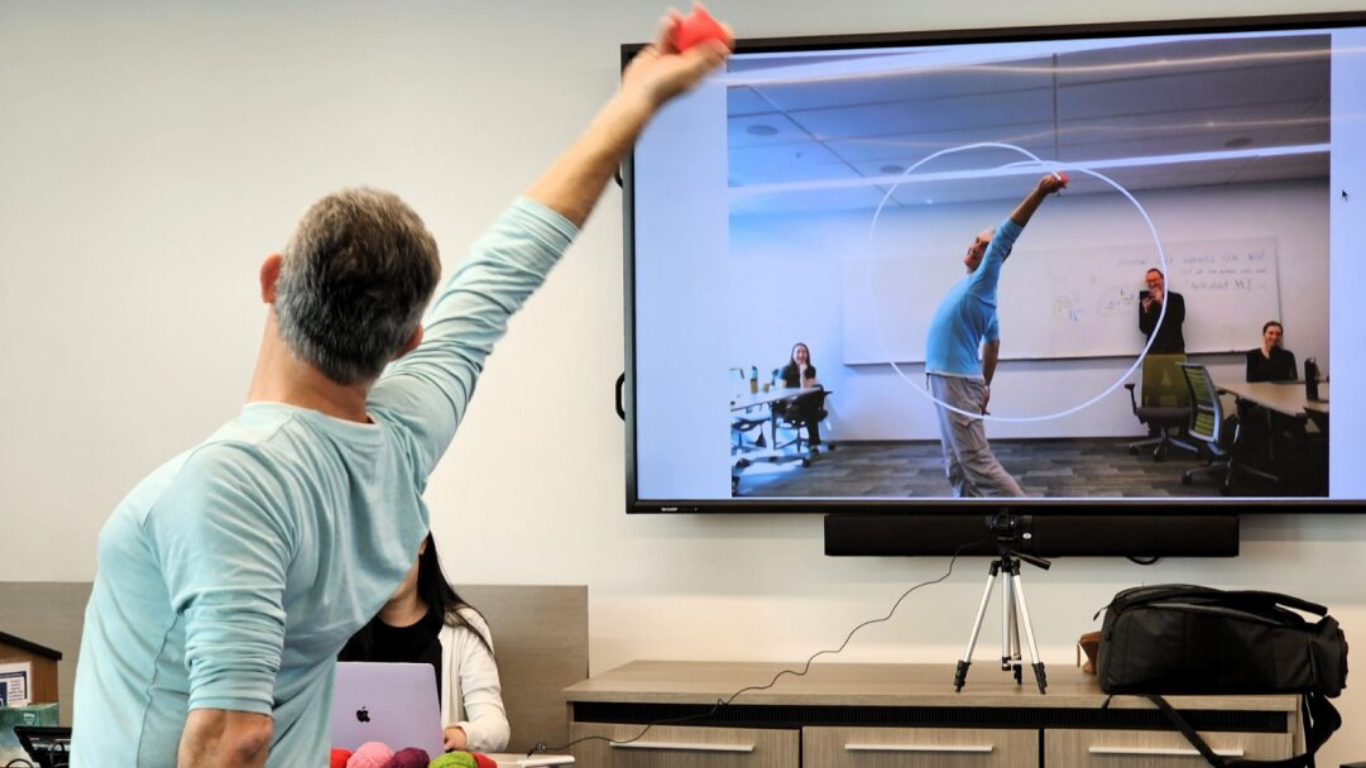What do Balinese dancing and geometrical proof have in common? Turns out that in both of these disparate practices, we imagine lines to solve the common problem of perceptually engaging the environment to perform sensorimotor tasks. In dance, these lines have been called “attentional anchors.” In geometry, these lines are called “auxiliary constructions.” But whereas dancing may come naturally to people and bear cultural identity and personal meaning, geometry is often viewed as unnatural and having nothing to do with the body. What if we created blended dance~geometry spaces where children could draw on their natural attentional anchors to generate auxiliary lines?
Figure 1. Students are working on a dancing-geometry problem on the GRiD
Geometry Resources in Dance (GRiD) is a gridded floor mat to objectify tacit attentional anchors for movement coordination into auxiliary lines for geometric practice. Students attend to, and foreground, particular lines on the mat in order to coordinate their dance movements. These tacit attentional anchors then become explicit auxiliary lines for geometric practice. We have been collecting data from fifth-grader students (9th – 13th years old) in both Bali (Indonesia) and California (United States) with various backgrounds in Balinese dancing.
Rationale
Creative geometry problem-solving and reasoning often require constructing auxiliary lines or other elements. However, as studies have found, teaching how to construct auxiliary lines is not easy because students get confused about which lines or elements will be helpful for them. So we asked: What would be a situation where the lines “come” intuitively as one’s strategy to solve a problem? As Ratih, the lead researcher in our project, sought the answer, she reflected on her experiences as both a mathematics educator and a Balinese dancer. Auxiliary lines are intuitive for her: they help her navigate daily tasks and solve mathematical problems. It started with her Balinese dance practice, where she spontaneously imagined various lines around her to organize complex dance movements (see the following video for an example of a Balinese dance lesson).
We would like to foster similar intuitive strategies in students, so how do we bridge the professional discourse across the practices, so that, just like Ratih, all children can learn mathematics through dancing and perhaps dance through mathematics? We proposed GRiD, a gridded floor mat developed within the embodied design research framework (Abrahamson, 2014). GRiD is designed to create opportunities for students to objectify the imaginary perceptual constructions, which they spontaneously generate to coordinate their dance movements, in the form of actual auxiliary elements used in geometrical reasoning.
Figure 2. Components of GRiD – Geometry Resources in Dance. GRiD comprises a gridded mat and accessories such as markers, stickers, highlighters, straws, connectors, yarn, pipe cleaners, and elastic bands.
Activities
We designed dancing geometry problems where students perform a Balinese dance maneuver on GRiD. We were interested in understanding whether and how dancing on GRiD could lead to geometrical reasoning. Here are some examples of the problems.
Sample Problem
Tapak Sirang Pada, a basic Balinese dance posture: heels meet, and toes open diagonally at ninety degrees. Viewed from above, our feet will form this shape.
Figure 3. Illustration of feet configuration in Tapak Sirang Pada
We ask students to enact the movement, evaluate if they are performing it correctly, and then explain how they can tell it is correct. Next, using GRiD lines, students re-perceive the dance form geometrically to justify their reasoning. Finally, they move to different locations on GRiD, per the choreography sequence, yet all the while locating the appropriate line formations.
Sample responses
Figure 4. Examples of student’s reasoning about Tapak Sirang Pada on GRiD
Figure 4 presents an example of how students gauge their Tapak Sirang Pada form. Working with GRiD, they shift to a geometrical discourse—they construct auxiliary lines (blue and yellow) to argue that their feet’s aperture is a ninety-degree angle (green lines). Then, as they relocate their Tapak Sirang Pada form to other areas on GRiD, per the dance sequence, they construct a new attentional anchor (see purple triangles).
Project Team
Ratih Ayu Apsari, Dor Abrahamson
Research Assistants
Surya Ayu Audina (Fall 2023), Sekar Nareswari Setyanto (Spring-Summer 2024), Henry Stier (Summer 2024), Dewi Sandra (Fall 2024) Anastasia Kathleen Wirjadi (Fall 2024-Spring 2025)
Undergraduate Mentored Researcher (EDSTEM C122)
Fall 2023: Arianna De Los Angeles Castro, Emma Nerea Kelly, Tiffany Hoang
Spring 2024: Sierra Nicole Hahn, Olivia Kathryn Kulchin, Jacob Antonio Perez, Xumo Huang, Alma Denisse Tolentino, Justin Yan
Fall 2025: Esperanza Barragan, Laura Pena
Figure 5. Ratih, Arianna, Emma, and Tiffany (from left to right) during the CalTeach poster presentation session in Fall 2023
Undergraduate Research Apprentice Program (URAP)
Fall 2024: Ilona Joline Surjorahardjo, Sunny Zhou
Spring 2025, Fall 2025: Ilona Joline Surjorahardjo
Project Collaborations
Digital GRiD: Real-time movement tracer for embodied geometry learning
Project Team: Ratih Ayu Apsari, Yangyang Yang
Digital GRiD was funded by the Jacobs Institute for Design Innovation at the University of California, Berkeley, in Spring 2024. We designed a real-time movement tracer for students to make sense of geometrical concepts, such as the concept of a circle, through full-body engagement.
Figure 6. Yangyang illustrates drawing with a colored object through real-time color detection using webcam input
Figure 7. Ratih with one of the visitors of Jacobs Spring Design Showcase trying the DIgital GRiD in Spring 2024
Figure 8. Ratih (left) and Yangyang (right) during Jacobs Spring Design Showcase
GRiD Workshop at EDaMMLA
Organized by the University of California Berkeley and the University of Oslo, the International Workshop on Embodied Learning and Multimodal Learning Analytics (EDaMMLA) aims to explore the analysis of multimodal learning in embodied learning. During the GRiD session, participants engaged in a participatory presentation on the connection between traditional Balinese dancing and mathematics teaching and learning.
Figure 9. Ratih made the invisible reference lines she used for performing Balinese dance posture and movement perceptible by arranging colorful yarns. Other participants from UC Berkeley helped to hold the yarns.
During the event, attendees had the opportunity to take part in a traditional Balinese dance lesson led by renowned Balinese dancer and teacher, I Made “Cat” Suteja. This activity allowed us to delve into the possibilities of multimodal learning analysis in the realms of dance, mathematics, and rhythm. Some participants utilized full-body motion-capture gear to collect multimodal bio-kinematic sensor data on their movement dynamics, while others opted for physiological sensor vests.
Figure 10. From left: Ratih Ayu Apsari (PhD Student in Learning Sciences and Human Development), Ami Shulman (US-based Movement Director, Feldenkrais Method practitioner), I Made “Cat” Suteja (internationally renowned Balinese dancer and instructor), Dr. Bilge Serdar Göksülük (dancer and researcher, RITMO, Norway)
In this session, we also tested the Digital GRiD prototype to explore various emerging strategies for using the body to understand geometric objects.
Figure 11. Alik Palatnik, EDaMMLA participant from The Hebrew University of Jerusalem, trying the real-time movement tracker of Digital GRiD
GRiD Workshop at Copernicus Science Center
In the summer of 2024, Geometry Resources in Dance (GRiD) was invited to the Copernicus Science Center (Centrum Nauki Kopernik/CNK) in Warsaw, Poland. Ratih presented the design principles, activities, and artifacts of GRiD to the Copernicus research team, sharing insights on how the design can be implemented to support children’s learning through embodied and culturally grounded approaches.
Figure 12. Left: Copernicus staff and colleagues demonstrating Poland’s traditional dance after listening to Balinese traditional dance during the GRiD session. Right: Ratih and Ilona Iłowiecka-Tańska, the Deputy Program Director for Innovations at Copernicus.
As a follow-up, GRiD returned to the Copernicus Science Center for a hands-on workshop with the Center’s educators and researchers in Summer 2025. Ratih facilitated collaborative design sessions focused on adapting GRiD, rooted initially in Balinese dance and cultural practices, to the Polish context. The workshop combined presentation, participation, and co-design activities: participants first experienced the GRiD materials, explored how students might engage with them, and reflected on the mathematical and cultural dimensions of the design. In the second phase, small groups brainstormed, prototyped, and showcased locally inspired adaptations. The session sparked rich discussion and creative reinterpretations, demonstrating how GRiD’s principles can travel and transform across cultural settings.
Figure 13. Examples of participants brainstorming and showcasing their design ideas during the GRiD workshop at the Copernicus Science Center in 2025.
Figure 14. Ratih and participants after completing the 4-hour GRiD 2025 workshop at the Copernicus Science Center
GRiD Workshop at Expand Your Horizon at Berkeley
On April 12, 2025, Geometry Resources in Dance (GRiD) was featured as one of the hands-on workshops at Expanding Your Horizons (EYH), a UC Berkeley initiative that introduces STEM-related careers and projects to 5th–to 8th–grade girls, trans youth, and gender non-conforming and/or non-binary students. Ratih served as the lead facilitator, supported by undergraduate research assistants Joline and Kathleen (Spring 2025 undergraduate research assistant cohort).
Figure 15. Joline, Ratih, and Kathleen (left to right) facilitating the Dancing Geometry workshop during Expanding Your Horizons at Berkeley.
Acknowledgment
Ratih Ayu Apsari expresses her deep gratitude to the Indonesia Endowment Fund for Education (LPDP) as the scholarship donor of her Ph.D.
Publications
- Apsari, R. A., & Abrahamson, D. (2026, March). Flooring dance: From perception to inscription in a culturally situated embodied geometry design. “Single paper” presented at the annual meeting of the European Association for Research on Learning and Instruction (EARLI) Special Interest Groups 10, 17, 21 & 25. University of Augsburg, Augsburg, Germany, March 25–27, 2026.
- Apsari, R. A., & Abrahamson, D. (in press). Culturally situated embodied design: A cognitive–anthropological investigation of Balinese spatial practice toward grounding geometry. In X. Yao, A. McCloskey, R. M. Zbiek., & R. Martinez (Eds.), Proceedings of the 47th annual meeting of the North-American Chapter of the International Group for the Psychology of Mathematics Education. PMENA.
- Apsari, R. A., & Abrahamson, D. (2025). Strings attached: A Balinese dance from attentional anchors to auxiliary constructions. In T. Verhoeff, D. Swart, S. L. Gould, & E. Torrence (Eds.), Proceedings of Bridges 2025: Mathematics and the Arts (pp. 539–542). Tessellations Publishing. http://archive.bridgesmathart.org/2025/bridges2025-539.html
- Apsari, R. A., & Abrahamson, D. (2025). Grounding mathematics learning in culturally authentic movement practices: From attentional anchors in Balinese dancing to auxiliary lines in geometry reasoning. In A. Rajala, A. Cortez, R. Hofmann, A. Jornet, H. Lotz-Sisitka, & L. Markauskaite (Eds.), Proceedings of the annual International Conference of the Learning Sciences (ICLS 2025) (pp. 92–100). (pp. 92–100). ISLS.
- Apsari, R. A. (2025). Geometry Resources in Dance (GRiD): Embodied design-based research to foster the construction of auxiliary lines in solving geometry problems from tacit attentional anchors in movement practice. Poster presented for the New Members Session Poster Presentations, The International Conference of the Learning Sciences. ISLS.
- Apsari, R.A. (2024). Dancing Geometry: An embodied design for the culturally situated mathematics classroom. Online Guest Lecture for Universitas Islam Raden Rahmat, Malang, Indonesia (December 13, 2024).
- Apsari, R. A., & Abrahamson, D. (2024). Dancing geometry: Imagining auxiliary lines by reflecting on physical movement. International Journal of Mathematical Education in Science and Technology. 1-28. https://doi.org/10.1080/0020739X.2024.2427099
- Castro, A.D.L.A., Kelly, E.N., Hoang, T., & Apsari, R.A. (2023). Elicitation of multimodal mathematical reasoning in Balinese dance through verbal and non-verbal justification. Poster presented for CalTeach Poster Session, University of California, Berkeley.
- Apsari, R.A. (2023). Grounding auxiliary geometrical constructions as semiotic articulation of tacit proprioception: The case of basic posture in Balinese dance. Poster prepared for Research Day, Graduate School of Education, University of California, Berkeley.
- Apsari, R.A. (2024, April). Grounding geometry as movement discourse: The case of auxiliary constructions in Balinese dance. In D. Abrahamson (Chair) & S. Gerofsky (Discussant), In-sight out: Challenges and opportunities in learning mathematics through negotiating egocentric and allocentric perspectives. Symposium presented for the SIG Research in Mathematics Education at the annual meeting of the American Educational Research Association, Philadelphia, April 11–14.
- Apsari, R.A. (2024). Grounding Auxiliary Geometrical Constructions as Semiotic Articulation of Tacit Attentional Anchors: The Case of Balinese Dance. Poster presented for Research Day, Berkeley School of Education, University of California, Berkeley.
- Hahn, S., Tolentino, A., Kulchin, O., Huang, X., Perez, J., Yan, J., Apsari, R.A. (2024). Geometry in Balinese Dance. Poster presented for EDSTEM C122 Spring Semester, University of California, Berkeley.
- Apsari, R.A. (2023). Dancing geometry: Reimagine the new ways of learning mathematics. Invited speaker for an online conference in mathematics education conducted by the mathematics education study program, Universitas Mataram, Mataram, Indonesia (November 18, 2023).
Invited Talks and Workshops
- Apsari, R. A., & Abrahamson, D. (2025). Culturally situated embodied design: A framework for grounding mathematical concepts in students’ authentic cultural practices. Invited lecture in P. Nilsson (Chair), Design research in mathematics education <Symposium>. Linnæus University, Växjö, Sweden, October 29, 2025.
- Apsari, R. A. (2025). Culturally situated mathematics design: Balinese local spatial Practice as a Semiotic Resource for Geometric Reasoning. Invited speaker in B. Z. Melani (Chair), The 7th International Conference on Education and Social Science (ICESS), Universitas Mataram, Indonesia, July 10, 2025
- Apsari, R. A. (2025). Culturally Situated Embodied Mathematics Design: Tracing the Invisible with Geometry Resources in Dance (GRiD). Invited speaker in Kurniasari, I., Prawoto, B.P., & Lestariningsih, L. (Chairs). The 2nd International Conference of Interdisciplinary Research and Studies in Mathematics (Inciresma 2025), Universitas Negeri Surabaya, Indonesia, July 19, 2025
- Apsari, R. A. (2025). Dancing geometry. Facilitator in K. Schaffer (Program Coordinator). Dancing and Mathematics Family Day Activity, Bridges: Mathematics, Art, Music, Architecture, Education, Culture Conference <Workshop>, Eindhoven, the Netherlands, July 17, 2025
- Apsari, R. A. (2025). Culturally situated embodied mathematical design. In Skrzypowska, J. (Chair). Workshop for Educators and Researchers at the Tinkatorium Station, Copernicus Science Center, Warsaw, Poland, July 4, 2025
- Apsari, R. A., Surjorahardjo, I.J., & Wirjadi, K. (2025). Expand Your Horizon at Berkeley, Workshop for 5th–8th grade girls, trans youth, and gender non-conforming and/or non-binary students, University of California, Berkeley, USA, April 12, 2025
- Apsari, R. A., (2024). Dancing geometry: Embodied-design for culturally situated mathematics classroom. Invited lecturer, Elementary School Teacher Education Program, Universitas Islam Raden Rahmat, Malang, Indonesia, December 13, 2024
- Apsari, R. A. (2025). Balinese dance and embodied mathematical design <Participatory presentation>. In D. Abrahamson & A. R. Jensenius (Workshop Chairs), Embodied Design and Multimodal Learning Analytics, Berkeley, California, USA. https://edrl.berkeley.edu/workshops-and-symposia/edammla-international-workshop/
- Apsari, R. A. (2025). Invited speaker. In A. Amrullah (Chair). Seminar Nasional Pendidikan Matematika dan Terapan (National Seminar on Mathematics Education and Application), Universitas Mataram, Indonesia, November 18, 2023
- Apsari, R. A. (2025). Invited speaker. In Scientific Adventures for Girls, Washington Elementary School, Berkeley, USA, November 16, 2023
Grants
- Jacobs Institute Innovation Catalysts, Spring 2024
- Bridges Conferences Travel Grant, Summer 2025



